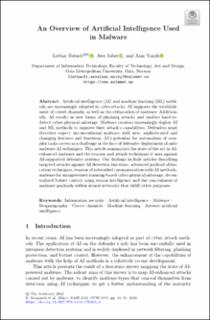| dc.contributor.author | Fritsch, Lothar | |
| dc.contributor.author | Alzarqawee, Aws Naser Jaber | |
| dc.contributor.author | Yazidi, Anis | |
| dc.date.accessioned | 2023-10-05T12:39:51Z | |
| dc.date.available | 2023-10-05T12:39:51Z | |
| dc.date.created | 2022-11-25T14:44:54Z | |
| dc.date.issued | 2023 | |
| dc.identifier.isbn | 9783031170294 | |
| dc.identifier.uri | https://hdl.handle.net/11250/3094520 | |
| dc.description.abstract | Artificial intelligence (AI) and machine learning (ML) methods are increasingly adopted in cyberattacks. AI supports the establishment of covert channels, as well as the obfuscation of malware. Additionally, AI results in new forms of phishing attacks and enables hardto- detect cyber-physical sabotage. Malware creators increasingly deploy AI and ML methods to improve their attack’s capabilities. Defenders must therefore expect unconventional malware with new, sophisticated and changing features and functions. AI’s potential for automation of complex tasks serves as a challenge in the face of defensive deployment of anti-malware AI techniques. This article summarizes the state of the art in AI-enhanced malware and the evasion and attack techniques it uses against AI-supported defensive systems. Our findings include articles describing targeted attacks against AI detection functions, advanced payload obfuscation techniques, evasion of networked communication with AI methods, malware for unsupervised-learning-based cyberphysical sabotage, decentralized botnet control using swarm intelligence and the concealment of malware payloads within neural networks that fulfill other purposes. Keywords: Information Security, Artificial Intelligence, Malware, Steganography, Covert Channels, Machine Learning, Adverse Artificial Intelligence | en_US |
| dc.language.iso | eng | en_US |
| dc.relation.ispartof | Nordic Artificial Intelligence Research and Development: 4th Symposium of the Norwegian AI Society, NAIS 2022, Oslo, Norway, May 31-June 1, 2022, Revised Selected Papers | |
| dc.relation.uri | https://link.springer.com/book/9783031170317 | |
| dc.rights | Navngivelse 4.0 Internasjonal | * |
| dc.rights.uri | http://creativecommons.org/licenses/by/4.0/deed.no | * |
| dc.subject | Cybersecurity | en_US |
| dc.subject | Cybersikkerhet | en_US |
| dc.subject | Kunstig intelligens | en_US |
| dc.subject | Artificial intelligence | en_US |
| dc.subject | Malware | en_US |
| dc.subject | Malware | en_US |
| dc.title | An overview of artificial intelligence used in malware | en_US |
| dc.type | Chapter | en_US |
| dc.type | Conference object | en_US |
| dc.description.version | publishedVersion | en_US |
| cristin.ispublished | true | |
| cristin.fulltext | original | |
| cristin.qualitycode | 1 | |
| dc.identifier.cristin | 2081300 | |
| dc.subject.nsi | VDP::Datateknologi: 551 | en_US |
| dc.subject.nsi | VDP::Computer technology: 551 | en_US |
| dc.subject.nsi | VDP::Annen informasjonsteknologi: 559 | en_US |
| dc.subject.nsi | VDP::Other information technology: 559 | en_US |

